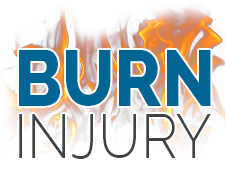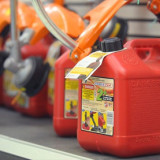Cooking Safety
Cooking is the number one cause of fires and burn injuries in the United States. The majority of cooking fires start when cooking food is left unattended. Burn injuries are often worsened or caused by home residents or food service workers attempting to extinguish a fire. Following safety practices while cooking can help prevent burn injuries and fires. Cooking Safety at Home Home cooking should only be done by individuals that are aware and well rested. Cooking while intoxicated or tired is dangerous. Reaction times may be slowed or individuals may become distracted. When frying, grilling, or broiling, individuals should be present in the kitchen at all times. When roasting or baking, the food should be checked regularly and timers should be set as a reminder. All flammable materials and substances should be kept away from flames and hot surfaces. Home Fire Prevention Certain steps can be taken to prevent cooking fires from spreading. Since fires need oxygen to grow and spread, keeping a lid close while sautéing or frying is helpful for extinguishing flames in a pan. Closing an oven and turning off the heat can help to prevent oven fires from spreading. Adding food to oil slowly and monitoring the oil temperature can help prevent dangerous oil splashes from occurring and starting fires. If it is not possible to prevent a fire from spreading, individuals should exit the home immediately to avoid being burned and call emergency services for aid. Home Burn Prevention To prevent burns while cooking at home, individuals should utilize pot holders and exercise caution when removing items from a hot oven, microwave, or stove top. Home cooks should wear clothing that is tight fitting or short sleeved to avoid burn injuries from loose clothing catching fire or immersing in hot liquid. Metal should never be put into a microwave. Electrical appliances should be unplugged when not in use. Food Service Cooking Safety About 12,000 food service workers suffer burn injuries each year. A majority of these injuries are suffered by young and inexperienced workers as a result of rushing to keep up with business demands. Workplace or worker negligence regarding safety rules is also involved in many burn injury cases. Food Service Burn Injury Prevention Food service workers can avoid burn injuries by taking precautionary steps such as: Wearing oven mitts when handling hot pots and pans Covering pan fires with a lid Never moving a hot or burning pan from a cooking surface Wearing non-skid shoes to avoid sliding into hot surfaces Properly using electrical appliances Never reaching across hot cooking surfaces Sources: https://www.burnfoundation.org/programs/resource.cfm?c=1&a=10 http://www.cdc.gov/safechild/burns/ http://www.mass.gov/eopss/docs/dfs/osfm/pubed/flyers/cooking-safety.pdf...
read moreKeeping Homes Burn-Safe for Kids
According to the Centers for Disease Control and Prevention, 300 children under the age of 19 are hospitalized for burn-related injuries every day in the United States. On average, one child per day dies from burn injuries. Approximately 88 percent of all burn injury deaths are caused by home fires. It is imperative that adults are diligent to keep homes burn-safe for kids to prevent burn injuries. Home Burn Safety Having working smoke alarms in the home reduces the likelihood of fatality from fire injuries by 50 percent. Exercising caution to prevent house fires will also greatly reduce the risk of burn injuries for kids in the home. Home fire safety practices such as unplugging electronics when not in use and keeping flammable substances away from heaters will help to prevent house fires. To prevent scalding injuries from hot water, water heaters should not be turned above 120 degrees. Residents that do not own the home should work with landlords to ensure proper fire safety practices. Teaching Children Burn Safety The number of burn injuries suffered by children can be greatly reduced by teaching children about burn safety. Children should be taught to never play with matches or lighters and should be educated on the consequences. Children should also be taught never to touch hot items such as heaters and curling irons. To ensure safety in the case of a house fire, parents can speak to children about emergency fire escape plans. Running home fire drills can be interesting and educational for children, and can help to prevent panic in the case of an actual emergency. Children and Kitchen Safety Many children are burned in the kitchen when adults are cooking. Besides practicing safe cooking techniques such as never leaving cooking food unattended, adults must exercise additional caution when children are present in the home. Pot and pan handles should always be turned in to prevent children from grabbing or bumping handles. Children should be kept out of the kitchen as much as possible when very young. Kids should be prevented from accessing stoves, ovens, and microwaves except with supervision until the child has demonstrated maturity with use of these appliances. Children and Firework Safety In recent years, many children have been hospitalized or killed as a result of burn injuries from fireworks. Every type of legal firework is capable of causing serious injuries, and should be kept away from children. To prevent child burn injuries, families should attend fireworks shows which are run by professionals instead of setting off fireworks at home. Sources: http://www.cdc.gov/safechild/burns/ http://www.healthychildren.org/English/safety-prevention/all-around/Pages/Keeping-Safe-From-Burns.aspx...
read moreFireworks Safety 101
Sources: “Sparklers 16 percent of fireworks harm.” United Press International. June 22, 2009. “The Dangers of Fireworks.” Topical Fire Research Series. Volume 5, Issue 4. U.S. Fire Administration/National Fire Data Center. http://www.ameriburn.org/Preven/SummerSafetyEducator’sGuide.pdf http://www.cpsc.gov/en/Safety-Education/Safety-Education-Centers/Fireworks/ ttp://www.nsc.org/news_resources/Resources/Documents/Using%20Fireworks%20Safely.pdf Click For Hi-Res Version Use the code below to embed infographic <a href="https://burninjuryguide.com" target="_blank"><img src="https://burninjuryguide.com/wp-content/uploads/2014/07/DWK_Fireworks_Final_HighRes.jpg" alt="Fireworks Safety 101" style="width:100%;"...
read moreGas Cans Pose Severe Burn Injury Risk
According to the Consumer Product Safety Commission, at least 11 deaths and 1,200 emergency room injuries were caused by gas can explosions since 1998. Each of these reports involved explosions while gasoline was being poured from a red, plastic gasoline container. Despite the explosion and burn injury risk associated with plastic gas cans, roughly 100 million are in circulation around the United States. Gas Can Flashback Explosions The type of explosion occurring within these gas cans is known as a “flashback explosion.” These explosions occur under specific chemical conditions. Scientific testing conducted at the combustion lab at Worcester Polytechnic Institute confirms the flashback explosion theory. How a Flashback Works During a flashback explosion, gas vapor escapes a can containing a small amount of gasoline. If this escaped gas comes in contact with a spark or flame, it can ignite. After the initial ignition, the gas can “flash back” into the can. If the gas inside the can is composed of a certain concentration, it can ignite as well. This can lead to a flame explosion with potentially catastrophic results. Gas Can Explosion Injuries In 2010, Robert Jacoby suffered severe gas can explosion burns on more than 75 percent of his body. He accrued $1.5 million in medical costs after four months of burn unit hospitalization and several skin grafts and surgeries. Jacoby claims that there was no source of flame at the time of the explosion. This claim was confirmed by a fire investigator during the investigation of Jacoby’s lawsuit against the can’s manufacturer Blitz. Gas Can Explosion Death In 2010, 19-year-old Dylan Kornegay died after an infection resulting from third and fourth degree burns. The gas can Kornegay was holding exploded near his leg shortly after he used the can to pour gasoline to start a bonfire. The resulting burns covered more than 80 percent of his body. During his six-week stay at a burn center, Kornegay underwent 15 surgeries, including a partial leg amputation. Defective Gas Can Lawsuits During the past two decades, more than 80 lawsuits were filed against gas can manufacturers in the United States. These product liability lawsuits allege that the gas cans are defective in design due to the lack of a flame arrester. A flame arrester is a small piece of mesh or perforated disk designed to disrupt flame. Flame arresters are currently included in products such as metal “safety” gas cans and fuel tanks. Fuel arresters are also featured in other flammable liquid storage containers, including rum and charcoal lighter...
read more















